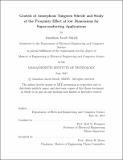Growth of amorphous tungsten silicide and study of the proximity effect at low dimensions for superconducting applications
Author(s)
Surick, Jonathan Jacob
DownloadFull printable version (3.892Mb)
Other Contributors
Massachusetts Institute of Technology. Department of Electrical Engineering and Computer Science.
Advisor
Karl K. Berggren.
Terms of use
Metadata
Show full item recordAbstract
In this thesis we successfully fabricate Superconducting Nanowire Single Photon Detectors (SNSPDs) out of a hybrid film with layers of both niobium nitride (NbN) and amorphous tungsten silicide (WSi). These hybrid devices use the proximity effect to potentially be more efficient than either of the materials alone. In order to make these devices, we first grew high quality samples of tungsten silicide and characterized them before growing hybrid films useful for nanoscale devices. We tested a hybrid chip with a number of nanowire devices expecting more efficient and faster detectors than the material alone. Though the findings are promising with the devices having reset times of around 2 ns and jitter of around 50 ps the devices did not saturate indicating that further experiments are needed to characterize the hybrid devices.
Description
Thesis: M. Eng., Massachusetts Institute of Technology, Department of Electrical Engineering and Computer Science, 2015. This electronic version was submitted by the student author. The certified thesis is available in the Institute Archives and Special Collections. Cataloged from student-submitted PDF version of thesis. Includes bibliographical references (pages 105-107).
Date issued
2015Department
Massachusetts Institute of Technology. Department of Electrical Engineering and Computer SciencePublisher
Massachusetts Institute of Technology
Keywords
Electrical Engineering and Computer Science.